Learning & Teaching
Leader: Lauren Bennett

Learning & Teaching
Leader: Lauren Bennett
In this newsletter, we’ll provide insights into the techniques and exercises being used, showcase student work, and offer tips on how you can support your child’s handwriting practice at home.
These foundational abilities are not just about penmanship but also play a crucial role in developing fine motor skills, boosting confidence, and enhancing overall literacy. Our dedicated teachers have been working diligently to ensure that each student gains proficiency and comfort in their writing.
Why is handwriting important?
Learning handwriting has lots of benefits and is important within our school to ensure students are developing their:
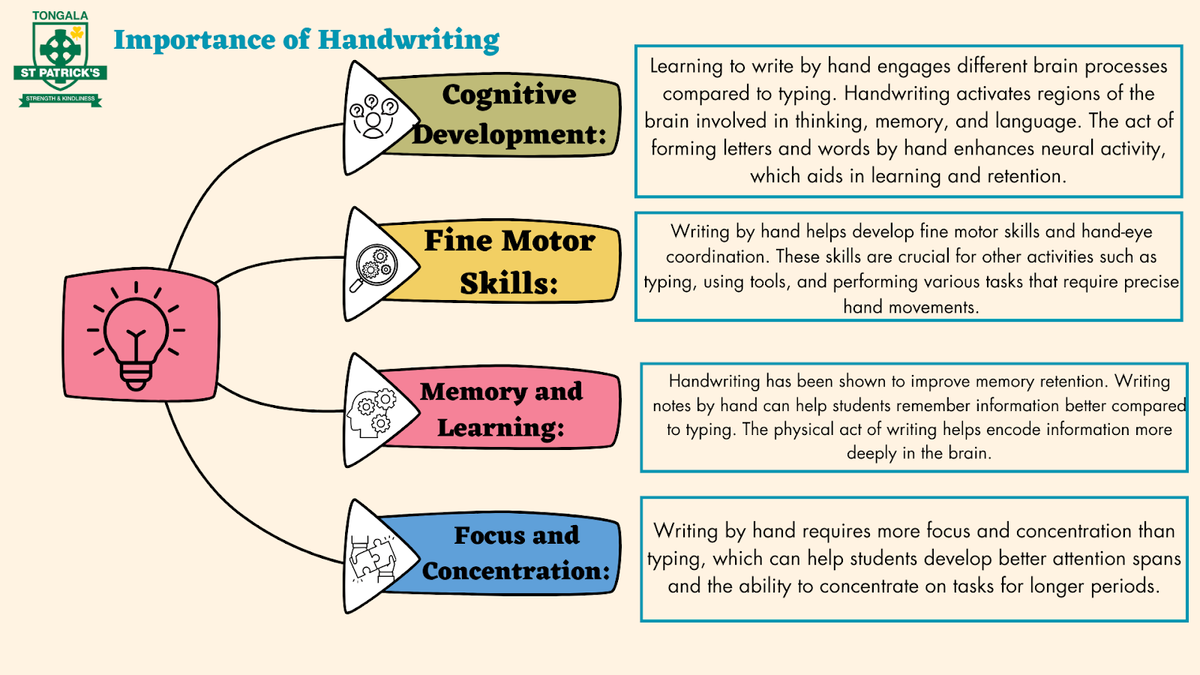

Why is correct letter formation important?
Letter formation is a fundamental aspect of handwriting that plays a crucial role in a child's educational development and overall cognitive growth. Here are several reasons why letter formation is important at St Patrick’s:
Foundation for Literacy: Proper letter formation is essential for reading and writing. When children learn to form letters correctly, they can more easily recognise those letters when reading and use them effectively in writing.
Writing Fluency: Consistent and accurate letter formation contributes to writing fluency. When children don't have to struggle with how to form each letter, they can focus more on the content of their writing, leading to better expression of ideas and thoughts.
Legibility: Correct letter formation ensures that handwriting is legible. This is important for effective communication, allowing others to read and understand the writer’s message. Illegible handwriting can lead to misunderstandings and frustration.
Cognitive Load: Proper letter formation reduces cognitive load, freeing up mental resources for other aspects of learning, such as spelling, grammar, and composition. When letter formation becomes automatic, children can concentrate more on the substance of their work.
Fine Motor Skills Development: Learning to form letters correctly helps develop fine motor skills and hand-eye coordination. These skills are important not only for writing but also for other tasks that require precision and control, such as drawing, playing musical instruments, and using tools.
Memory and Learning: Forming letters by hand aids memory retention and learning. The kinesthetic activity involved in writing reinforces the shape and sound of letters, helping children remember and understand them better.
Consistency and Speed: Proper letter formation contributes to writing speed and consistency. This is particularly important during timed assessments and note-taking, where being able to write quickly and clearly is beneficial.
Self-Confidence: Mastery of letter formation can boost a child’s confidence in their writing abilities. When children can write legibly and efficiently, they are more likely to participate in writing activities and take pride in their work.
Transition to Cursive: Correct letter formation in print writing lays the groundwork for learning cursive writing. Many of the skills involved in print handwriting, such as stroke order and direction, are directly transferable to cursive.
Avoidance of Bad Habits: Early instruction in proper letter formation helps prevent the development of bad habits that can be difficult to correct later. Poor handwriting habits can hinder academic performance and overall communication skills.
What is the correct language to use for letter formation?
When children are learning to write with correct letter formation, it is helpful to use the same language and verbal pathway as school to ensure there is consistency for the child. At St Patrick’s when students are learning initial letters and how to write them we use the same verbal pathway language. Here is an example of the language we use when introducing children to the correct letter formation:
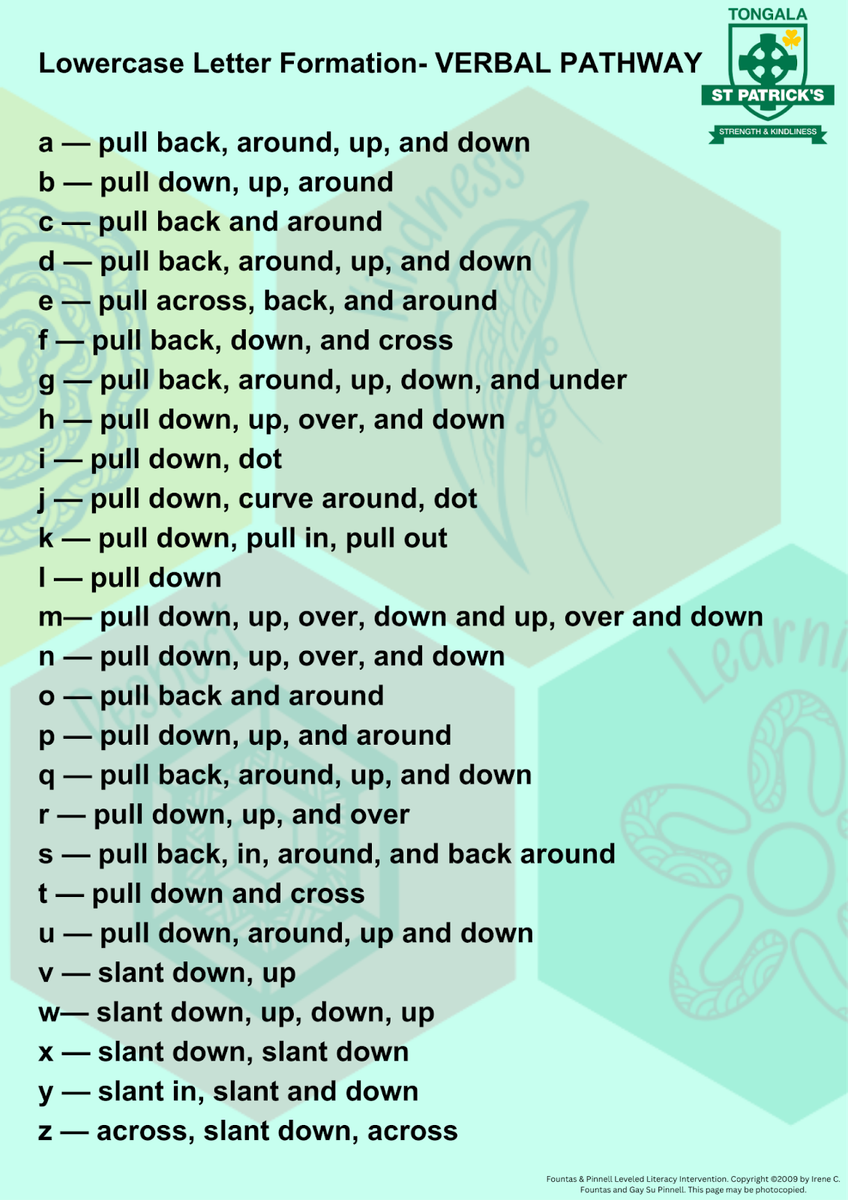

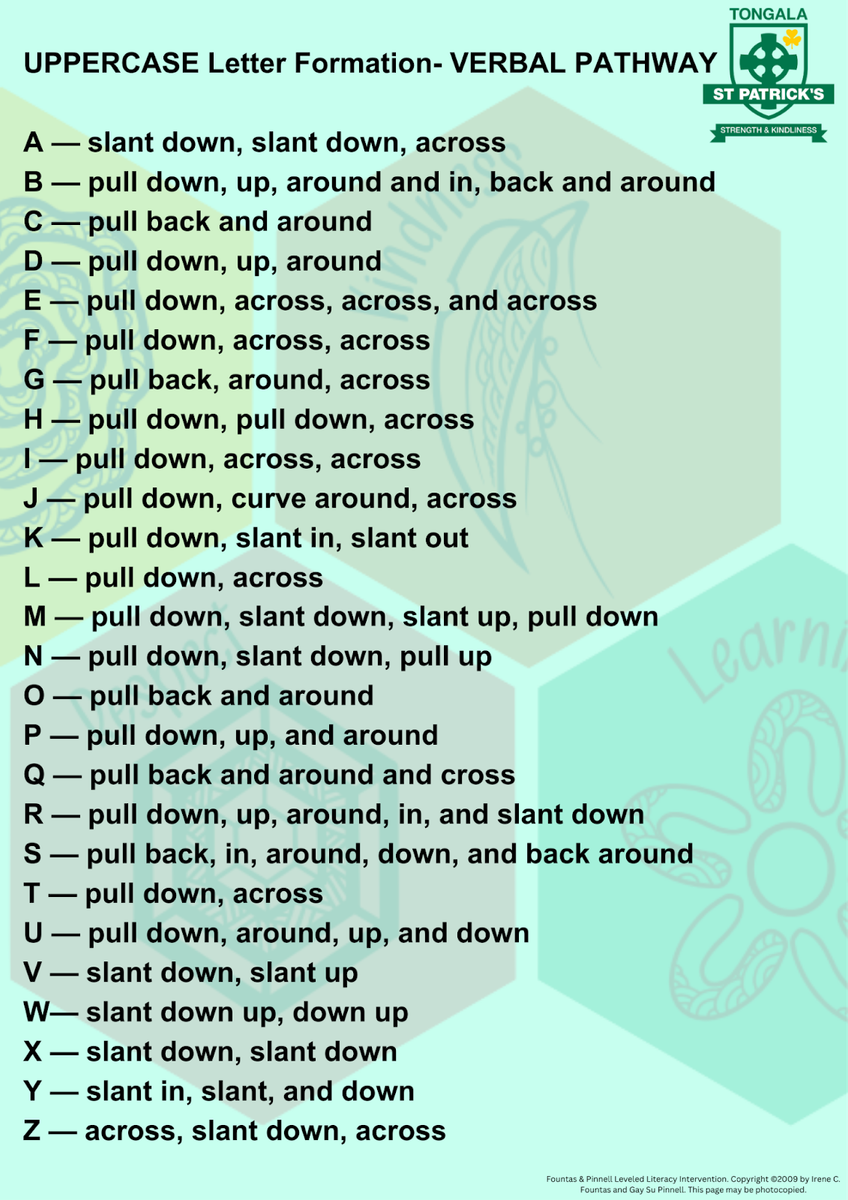

What is a pen license?
At St Patrick’s we celebrate students who have been working hard on their handwriting legibility and display consistency of high work standard, by giving them an opportunity to obtain a ‘St Patrick’s Pen Licence’. Students receive a pen license in Grade 3/4 when they have completed 10 pieces of work with exceptional handwriting and letter formation.
They are judged on demonstrating writing that is:
Once the students earn 10 stars for consistent handwriting they are eligible for a St Patrick’s pen licence. If they have completed exceptional handwriting and their classroom teacher believes they are responsible to write with a pen the student will be awarded their own ‘pen licence’ to keep.
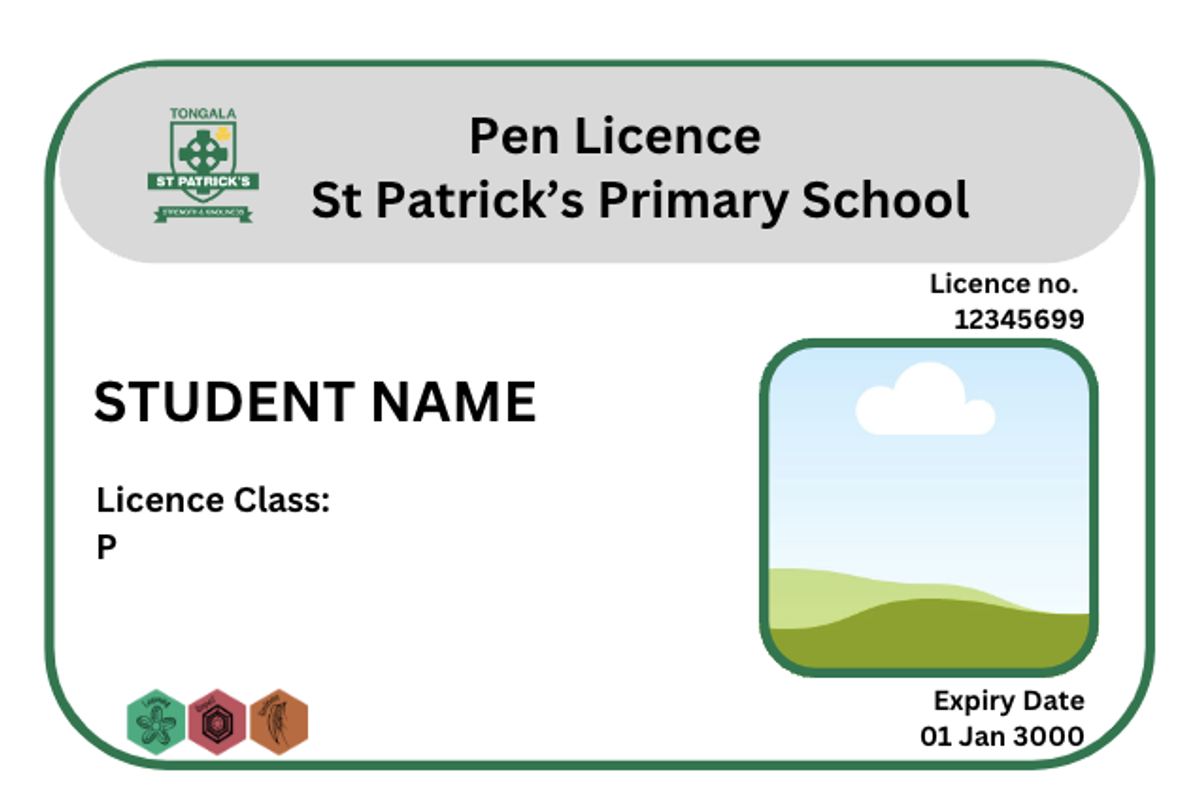

What can I do to support my child’s handwriting at home?
Parents can support their child's handwriting at home by providing an encouraging environment and engaging activities. They can do this by:
Our teachers are currently in ‘report writing mode’ which means that soon our families will be in ‘report reading mode’! To help with reading reports and support the big question of ‘what does this all mean?’ here is your report reading guide:
Why is it important to read your child's report?
Reading school reports is vital for families to stay engaged in their child's academic journey. These reports provide insights into a student's progress, strengths, and areas needing improvement. By reviewing them, families can celebrate achievements, address challenges, and collaborate with teachers to support their child's education. Staying informed through school reports helps ensure that students receive the encouragement and resources they need to succeed.
It is important that if you see anything on your child’s report that brings up questions or concerns for you that you share these with your child's classroom teacher so you can have your queries addressed. Doing this in a timely manner after reading the report is crucial to ensure things get discussed straight away and our concerns don’t grow over time.
Why should I share the report with my child?
Sharing school reports with your child and opportunity to have open communication and self-awareness. It allows children to understand their progress, celebrate their achievements, and recognize areas for improvement. Discussing the report together can boost their motivation, help set realistic goals, and encourage a proactive attitude towards learning. Sharing their report and results with them is an excellent way for your child to feel supported about their learning at school.
When we read our child’s reports we should follow this cycle:
Review: Read your child’s report
Share: Share your child’s report with them
Question: Note down your questions or concerns and speak with your child’s classroom teacher.


What do the progression points mean?
Progression points in a school report are key indicators of a student's development in various subjects. Understanding these points helps parents track academic growth over time and see how their child is progressing. All of the progression points for St Patrick’s align with the Victorian Curriculum standards and levels. Here is a look at what the different elements of the progression points mean in your child’s report.
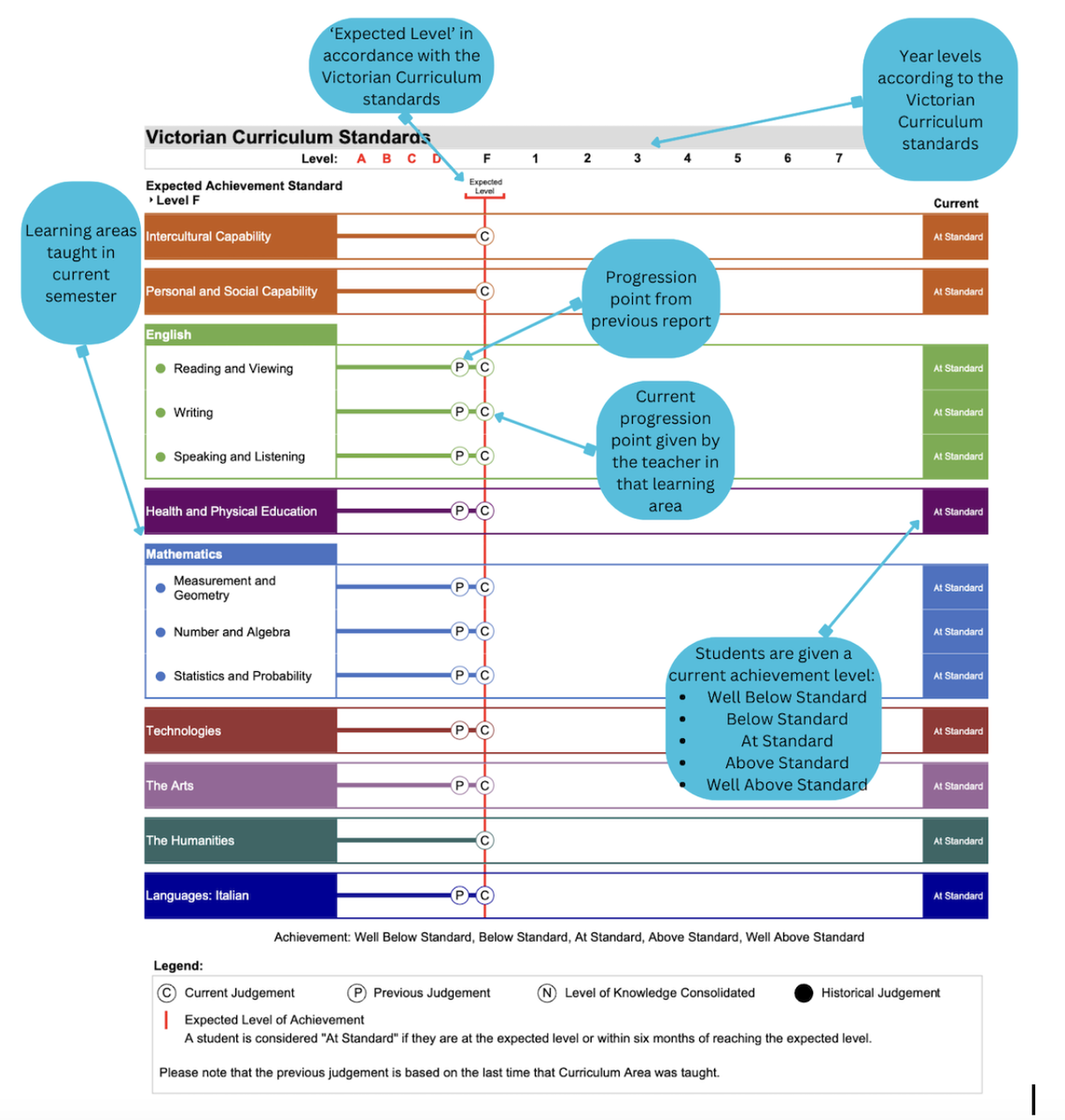

Why is my child’s attendance mentioned in their report?
Attendance is mentioned in your child's report because it plays a crucial role in their academic success. Regular attendance ensures that students do not miss out on important lessons, class discussions, and activities that contribute to their learning and development. At St Patrick’s if a student is sitting below 90% attendance they receive a comment in their Semester Report.
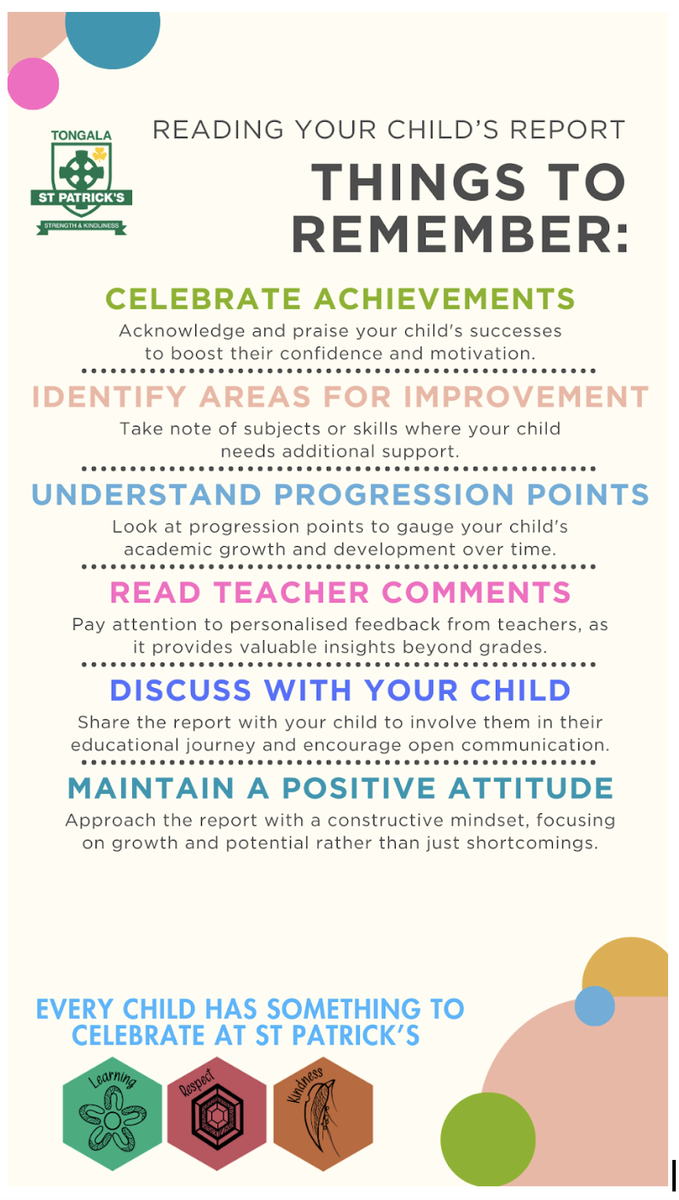

At St Patrick’s every student has a right to feel celebrated, welcomed and valued. All teachers and staff are committed to ensuring your child loves coming to school each day and works hard to ensure each student is being supported in their learning. We appreciate you being invested in your child’s learning by reading their report. With reports coming out in the next few weeks we ask that parents read them, celebrate and share with their child and follow up with classroom teachers if there are any questions.
Asking your child about their learning at school is a great way to show interest in their education and to support their academic growth. By asking about what they are learning and getting them to share it allows for their knowledge to strengthen. If you are looking for some questions to speak to your child about to talk more about school try a couple of these at the dinner table:

